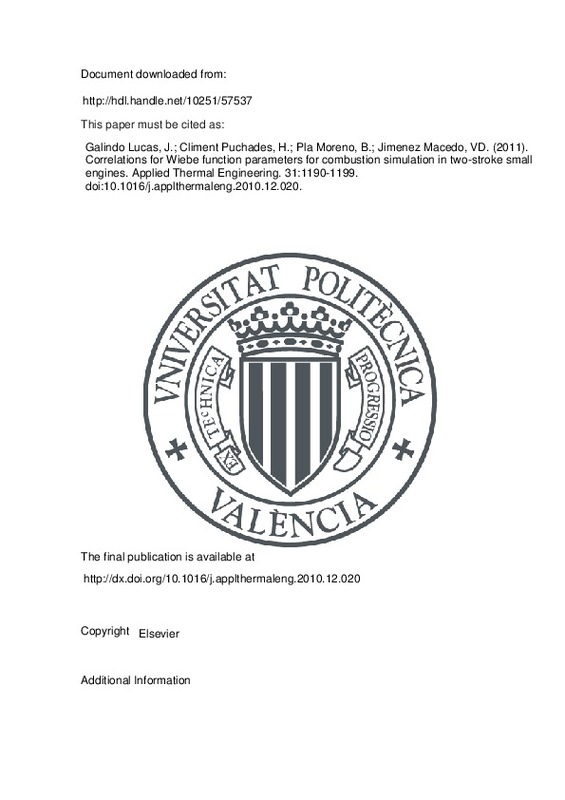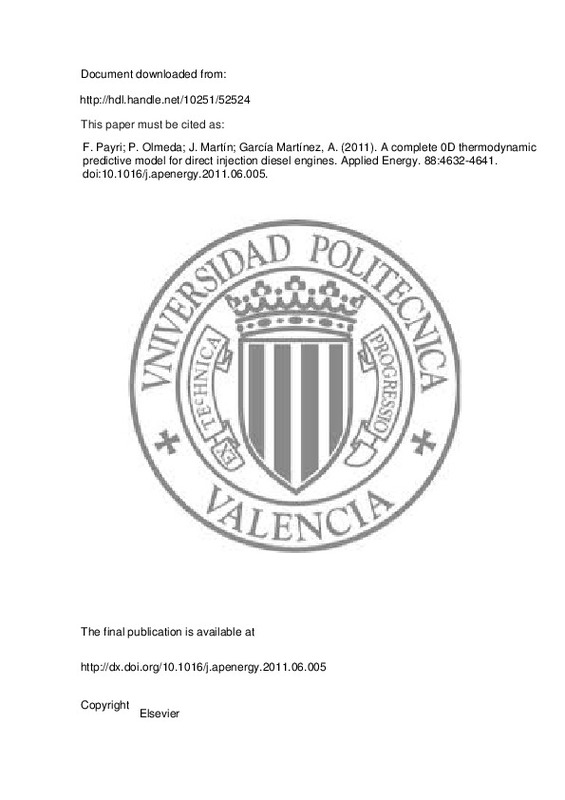Galindo Lucas, J.; Climent Puchades, H.; Pla Moreno, B.; Jimenez Macedo, VD. (2011). Correlations for Wiebe function parameters for combustion simulation in two-stroke small engines. Applied Thermal Engineering. 31:1190-1199. doi:10.1016/j.applthermaleng.2010.12.020
Por favor, use este identificador para citar o enlazar este ítem: http://hdl.handle.net/10251/57537
|
Título:
|
Correlations for Wiebe function parameters for combustion simulation in two-stroke small engines
|
|
Autor:
|

 Galindo Lucas, José
Galindo Lucas, José

 Climent Puchades, Héctor
Climent Puchades, Héctor

 Plá Moreno, Benjamín
Jiménez Macedo, Víctor Daniel
Plá Moreno, Benjamín
Jiménez Macedo, Víctor Daniel
|
|
Entidad UPV:
|
Universitat Politècnica de València. Departamento de Máquinas y Motores Térmicos - Departament de Màquines i Motors Tèrmics
|
|
Fecha difusión:
|
|
|
Resumen:
|
Combustion simulation in two-stroke engines becomes necessary not only for engine performance prediction but also for scavenge evaluation, since in-cylinder pressure and temperature are highly influenced by combustion ...[+]
Combustion simulation in two-stroke engines becomes necessary not only for engine performance prediction but also for scavenge evaluation, since in-cylinder pressure and temperature are highly influenced by combustion process evolution. Combustion simulation by using a Wiebe function is appropriate to be included in a 1D engine code for providing design criteria with fast and accurate calculations; the main drawback is the determination of the four Wiebe parameters needed to build up the in-cylinder heat release. This paper deals with a detailed methodology for heat release determination in two-stroke engines under a wide range of running conditions; obtained empirical data will serve for building ad-hoc Wiebe functions, whose four parameters will be finally correlated with engine related parameters derived from 1D simulations. Two different engines, with three exhaust systems each, varying engine speed and spark-ignition timing were used to obtain correlations far from particular situations. A multiple regression analysis stated that charge density, residual gas fraction, spark timing and mean piston speed were the significant engine parameters that influence on Wiebe parameters. Finally, two scenarios were considered regarding Wiebe parameters: (a) specific correlations different for each engine gave coefficient of multiple determination values higher than 98% when predicting indicated mean effective pressure, (b) a global correlation used for both engines provided R2 values of 93% in the 50 cc and 91% in the 125 cc engine. © 2010 Elsevier Ltd. All rights reserved.
[-]
|
|
Palabras clave:
|
HRR correlation
,
Phenomenological combustion model
,
Two-stroke engine
,
Wiebe's function
,
1-D simulation
,
Combustion pro-cess
,
Combustion simulations
,
Cylinder pressures
,
Design criterion
,
Empirical data
,
Engine parameter
,
Engine performance
,
Engine speed
,
Exhaust systems
,
Function parameters
,
Global correlation
,
Heat release
,
Ignition timing
,
Indicated mean effective pressure
,
Multiple regression analysis
,
Residual gas
,
Running conditions
,
Spark timing
,
Combustion
,
Diesel engines
,
Electric sparks
,
Engine cylinders
,
Heat engines
,
Ignition systems
,
Machine design
,
Regression analysis
,
Exhaust systems (engine)
|
|
Derechos de uso:
|
Reserva de todos los derechos
|
|
Fuente:
|
Applied Thermal Engineering. (issn:
1359-4311
)
|
|
DOI:
|
10.1016/j.applthermaleng.2010.12.020
|
|
Editorial:
|
Elsevier
|
|
Versión del editor:
|
http://dx.doi.org/10.1016/j.applthermaleng.2010.12.020
|
|
Tipo:
|
Artículo
|







![[Cerrado]](/themes/UPV/images/candado.png)




